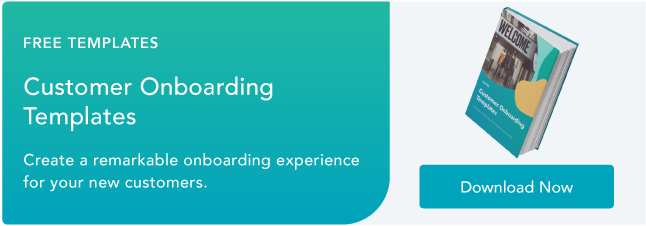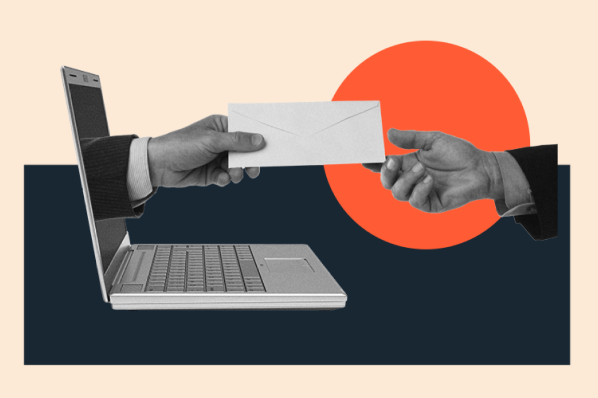Consumers desire the ability to interact with businesses digitally — whether it's shopping online or completing onboarding from home. Read ahead to learn how you can provide a seamless digital onboarding experience for your customers.
Continue reading or jump ahead:
- What is digital onboarding?
- Digital Onboarding vs. Traditional Onboarding
- Benefits of Digital Onboarding
- Digital Onboarding Best Practices
- Digital Onboarding Tools
What is digital onboarding?
Digital onboarding, also called remote onboarding, is the process of using online tools and software to get new customers added to your database or CRM.
Throughout the process, customers are able to get familiar with your product or service from wherever they're located, rather than in your store or office.

The digital onboarding process usually requires some type of identification or authentication from the customer to prove they are who they say they are.
This may include personal data, like an email address, birthday, or social security number. Or, in some cases, biometric information, like a fingerprint or face scan.
Digital onboarding also relies heavily on automation to streamline processes such as:
- Customer signups, purchases, and inquiry resolution
- Distribution of an onboarding questionnaire for new client data gathering
- Product information sharing via instructional videos and knowledge bases
- Know Your Customer, or KYC, verification (popular for banks and financial institutions)
Here's more context from Modyo about the digital onboarding process.
Digital Onboarding vs. Traditional Onboarding
Let's explore the digital, traditional, and hybrid approaches to onboarding.

Digital Onboarding
The main differentiator between digital onboarding and traditional onboarding is in the name: it's completely online.
Usually, this means your customers are signing up and interacting with your company on your website or mobile app.
Digital onboarding gives customers the freedom to begin the process wherever and whenever they'd like. This eliminates the need for customers to sit in your office or store and go through the process on your time.
Traditional Onboarding
Traditional onboarding — also known as on-site, or in-person onboarding — is the conventional process: A new customer visits a store or office to buy your product or sign up for your service.
Unlike digital onboarding, customers are required to be physically present in order to complete the onboarding requirements like verifying their identity, providing personal information, or filling out required forms.
On-site onboarding has the face-to-face benefits of building customer relationships. But the process can also put a strain on your time and resources.
Hybrid Onboarding
Semi-on-site, or hybrid, onboarding is a mix of on-site and digital onboarding. Rather than doing everything in-store or remotely online, the process is half and half.
For example: Let's say a customer comes into your store to make a purchase.
You give them an initial overview of the product and send them home with self-study resources. They then return to their preferred location to begin the onboarding process.
Another example would be if a customer came in to sign up for your service and you sent them a set of digital forms to fill out at home. You could then offer them the option to submit the forms in person or send them back over email.
Hybrid onboarding may seem like the best of both worlds, but managing both physical and digital files can be a lot for your customer onboarding specialists to handle.
Benefits of Digital Onboarding
Digital onboarding comes with more automation and a certain degree of separation from the customer, so you may feel that this process takes away the critical opportunity to make connections.
While you may have fewer face-to-face interactions with new clients, it's still possible to set yourself up for success with this strategy.
Digital onboarding brings various benefits, both for the consumer and your business.

We'll discuss them in more detail below.
Uninterrupted Business Operations
As a business, the most significant benefit of digital onboarding is that it allows you to continue operations, regardless of the circumstances.
Instead of coming to a halt because you can't invite customers in-store, they can come onboard whenever and wherever they want.
Even if they require a physical product to get started, they can receive it in the mail and begin onboarding once the product arrives.
Reduced Time and Costs
Digital onboarding can help you create workflow efficiencies through the use of automation.
Instead of having client success managers, or CSMs, repeat the same procedures for each customer — such as background verification or account setup — you can set these tasks up to run automatically in the background.
You could also create overarching content, like introductory product videos, that can be sent to all new clients upon signup.
This way, CSMs can focus more time and resources on customers with high-priority issues and questions that they can't solve independently.
Personalized Customer Experiences
Digital onboarding speaks to the consumer's desire to have a seamless, customized experience when interacting with a business.
In other words, digital onboarding allows consumers to personalize their own experience.
They can begin the process when they want and take the time they need to get acquainted, all at their own pace. There's also less pressure to fill out forms or ask questions than there would be in an in-person setting.
Access to digital onboarding tools also lets customers return to them if they have additional questions or want a refresher training every so often.
They can simply access the resources you've provided them without needing to contact a service rep or make a return trip to your store.
Increased Consistency and Accuracy
Taking your onboarding process to the digital space will help ensure that all of your customers are receiving the same experience.
Naturally, onboarding is bound to look a little different depending on which rep is providing the service. With digital onboarding, you can set up step-by-step automated processes for all customers to follow.
For example, your digital onboarding process could look something like this:
- A new customer purchases your product, and they're prompted to create an account online
- Once created, they receive an email with steps to verify their identity
- Once verified, they receive access to your knowledge base and guided informational videos on how to set up their product
You can also build checklists and confirmations into the process for your customers, so they don't miss any steps along the way.
Digital Onboarding Best Practices
The best practices for digital onboarding may look a lot like the best practices for general customer onboarding, but there are some nuances.

Let's explore a few below.
Understand who your customers are (and what they need).
While this is considered an overall business best practice, it's especially important to anticipate what your customers will need during a digital onboarding experience.
Unlike on-site onboarding, customers will need to be more self-sufficient in activating their product or service and answering their own questions along the way. So, make sure you set them up for success.
Look into the inquiries you get the most from customers during the onboarding process.
Do they get hung up in the technical set-up of your product? You could consider including guided video tutorials for new clients.
Do they abandon onboarding because they're unsure of next steps? Maybe emails prompting them to complete new tasks would be helpful.
And if you're not sure what your customers need, ask them.
Create a consistent multi-channel experience.
Today, consumers are on a number of different channels —from email to social media, and most importantly: mobile.
According to Statista, the number of mobile internet users in the United States has steadily increased, reaching an all-time high of over 282.5 million users in 2022.
The beauty of digital onboarding is that it allows you to create the multichannel experience that customers want. But, you have to make sure that experience is the same regardless of which platform a person is using.
Your onboarding experience should be adaptable, and new customers should always be able to easily pick up from where they left off.
For instance, if they start setting up an account on their desktop computer, they should be able to finish that process on another device like a phone or tablet.
Connect new customers with your success team.
Digital onboarding programs are designed to help new customers become regular users on their own. However, you don't have to lose the human element completely when you make the switch to digital.
Your support reps may no longer be hand-holding your customers throughout the onboarding process, but they're still an integral part in making sure new customers have the resources they need to be successful.
Keep the line of communication open between customers and onboarding specialists. Let customers know how to reach your support team and who to contact with any questions.
Customers want to know there are still 'real' people available to help them if they need it.
Looking for more best practices? Each week, HubSpot's Podcast Network hosts 'CSM Office Hours' as part of the Gain, Grow, and Retain series.
In the below episode, listen in as CSMs discuss onboarding and implementation tips and real-world insights.
Digital Onboarding Tools
Digital onboarding relies heavily on various tools that may not be front-and-center for your traditional onboarding strategy.
Featured Resource: Customer Onboarding Templates
Next, we'll discuss key tools to consider using in your digital onboarding process to ensure clients can still be successful.
Identity Verification Software
The first step in onboarding for many industries is typically centered around account set-up or new customer identity verification.
If you need your new customers to submit background documentation, like biometric data or government-issued documents, tools like IDenfy and Jumio can help automate this process for you.
This type of software can also help you confirm that your new customer is indeed a real person interested in your business.
Pro tip: If possible, choose verification software that integrates with your current systems. That way, you won't be adding any extra work for your onboarding team (they say thank you, by the way).
Video
Using video is a crucial pillar of successful digital onboarding.
Your in-person success teams may be physically showing a customer how to do something with your product or service. And with digital onboarding, you can share videos of this process.
In fact, consumers will appreciate this — 96% report having watched an explainer video to learn more about a product or service.
For businesses, a benefit to creating a video is that you can recycle it. You can create one product demo and send it to all of your customers, only making edits when there have been product upgrades or changes.
You'll save time by automating this portion of your onboarding process, and reps can spend more time on high-priority customer issues rather than foundational level instruction.
Pro tip: Try not to recreate the wheel if you don't have to. In most cases, you can transform your traditional in-person interactions into video content by recording product demonstrations, walkthrough, or live tutorials.
Knowledge Base
A knowledge base is a self-service library that includes helpful information about your business's products, services, and related topics.
Customers have easy access to them and can seamlessly find answers to their questions.
HubSpot offers knowledge base software that will guide you through the process of creating one for your own business.

With digital onboarding, this resource is an impactful tool as it is a way for customers to get answers to any additional questions they may have traditionally asked a CSM in person.
Should you choose to make your digital onboarding more of a self-guided process, having these knowledge bases also reduces the need for additional touchpoints.
Pro tip: If you're not sure what to include in your knowledge base, ask your customer service team. Chances are they have a good sense of the types of information your new customers are typically looking for.
eLearning
eLearning is delivering informational courses electronically.
For digital and remote onboarding, these courses can be virtual introductions and walk-throughs that familiarize customers with what they've just bought. This would replace an in-person session where a customer works 1:1 with a success manager.
The image below displays HubSpot eLearning courses that teaches customers how to use Service Hub features.

If the courses you create are still available post-completion, customers can return to them when they have questions before contacting a service rep.
And, as with video, eLearning is a time-saver for your business. You only have to make courses once, and you can reuse and update the content as needed.
Pro tip: Create eLearning courses that are self-paced and asynchronous so customers are free to take as much time as they need to feel comfortable with your offer. This is another perk that comes along with digital onboarding.
Mobile Apps
Mobile apps are a valuable supplementary tool for remote onboarding, especially because they are easy to access for customers with a mobile phone.
It also gives customers an alternate way to become familiar with your product if they prefer using a handheld device over a desktop.
Using mobile apps also ensures that customers have access to onboarding materials regardless of where they are. If they have a question during their process, they can simply open the app and search for a solution.
Pro tip: Make your knowledge base accessible via your mobile app. This makes it easy for customers to quickly search through your libraries without needing to actually pick up the phone and call your business.
Digital Is the New Traditional
In terms of content, digital onboarding is not so different from in-person and hybrid onboarding.
You still work to ensure your customers can be as successful as possible with your products, but the process is simply more automated and self-guided than it would be on-site.
If you give it a try, you'll likely find that customers can still use your products and services to achieve their goals, and they'll be excited about interacting with you in a new way.
Editor's note: This post was originally published in June 2021 and has been updated for comprehensiveness.
Customer Onboarding








![10 Customer Onboarding Challenges You Might Face This Year [+Expert Tips]](https://53.fs1.hubspotusercontent-na1.net/hubfs/53/ai%20customer%20service%20predictions%20(2).webp)

![Perfect your customer onboarding with our expert tips [+ checklist]](https://53.fs1.hubspotusercontent-na1.net/hubfs/53/client-onboarding-best-practices-1-20251029-7553263.webp)
.webp)
